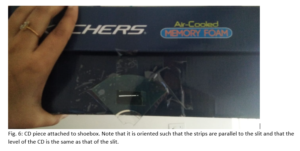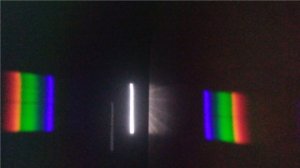
By Anwesha, Physics
College of Engineering and Physical Sciences, University of Birmingham
University life during a pandemic falls nothing short of strange. Laboratory work is replaced with online labs and socials from societies are replaced with engaging Zoom sessions. Nonetheless, the last academic year has been incredibly rewarding and exciting as a physics student. From DIY and online labs involving analysing data from the world’s largest particle collider – the LHC – to building a spectrometer using a shoebox and organising astronomy events, the past year has been quite eventful.

When online classes resumed last September, the module I was most keenly looking forward to was online lab. I was curious to see how this would be implemented online as physics is a subject which rewards best when tinkering around the lab. While the majority of this year’s online labs focused on data analysis and techniques, my highlight has to be getting the chance to work on building my very own visible light spectrometer using nothing more than a shoebox, an old DVD and some tape. By using the DVD as a diffraction grating, I was able to analyse the visible spectrum of several different light sources and using their signature characteristics, identify the

exact type of light emitted. By the end of the project, I had analysed the characteristics of over 5 different types of light sources including my laptop screen, the microwave oven lamp, and the sun amongst others. Despite being unable to access the physics departments labs, it was delightful to be able to do a lab-standard experiment from the comfort of my bedroom.
Semester 2 involved working on an online lab project with teammates and I was thrilled to work with my team on analysing data from proton – lead collisions in the ALICE detector at the CERN LHC. This project aimed to extract signals for two particles, namely the Xi minus and Omega minus baryons which fall into the category of multistrange baryons. Studying the conditions for the formation of these particles and their interactions can provide crucial evidence for understanding the early stages of the universe right after the Big Bang.
Another highlight of my year was being involved with AstroSoc. As Outreach Officer, I led the organisation for talks and events. Transitioning from in person events and observation nights initially proved to be a challenge, but we successfully launched three new events in an all-online platform and reached an audience larger than ever before. We kicked off summer with the launch of our shiny new YouTube channel and the debut of the 10 week talk series QUARANTINE Talks where we invited faculty members to talk about some of the leading astronomy subjects of today, ranging from quenching galaxies, to astronauts to exoplanets. The new academic year started off with our first ever celebration of the global World Space Week events, in collaboration with three other societies: WISE, SATNAV and SpaceSoc. We discussed the pros and cons of satellite technology and how we can ensure a sustainable satellite-technology future for the generations to come. More recently, we had our first-ever AstroSoc Legacy and Careers night as we recollected over 100 years of AstroSoc’s events, with several former AstroSoc committee members joining in for the night.
Despite the unprecedented challenges brought forth by this year, the greatest lesson we have learnt is that our ability to adapt to different circumstances is our biggest strength. This is what allows us to persevere as we look forward to a brighter future free from COVID-19.
